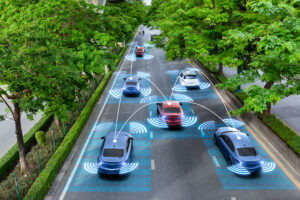
Advanced Driver Assistance Systems (ADAS)
Are you tired of constantly keeping your eyes on the road, worrying about potential hazards or accidents? Well, worry no more! In today’s fast-paced world, technology has made our lives easier and safer, and one remarkable innovation in the automotive industry is Advanced Driver Assistance Systems (ADAS). ADAS is a revolutionary set of technologies designed to assist drivers in their daily commute, providing features like adaptive cruise control, lane departure warning, and automatic emergency braking. Let ADAS be your second pair of eyes on the road, ensuring your safety and giving you a peace of mind like no other.

Introduction to Advanced Driver Assistance Systems (ADAS)
Welcome to an introduction to Advanced Driver Assistance Systems (ADAS)! In recent years, the automotive industry has made significant advancements in technology, particularly in the realm of vehicle safety. ADAS is at the forefront of these advancements, aiming to enhance driver safety, reduce accidents, and improve overall driving experience. In this article, we will explore the various types of ADAS, the components and sensors used, the advantages and challenges it presents, emerging technologies, regulations and standards, future trends, and the importance of user education and training.
1. Types of ADAS
1.1 Lane Departure Warning System (LDWS)
The Lane Departure Warning System (LDWS) is designed to detect unintentional lane departures and warn the driver through visual, auditory, or haptic alerts. By monitoring the vehicle’s position within the lane, LDWS helps prevent accidents caused by drifting out of the lane due to driver distraction or drowsiness.
1.2 Adaptive Cruise Control (ACC)
Adaptive Cruise Control (ACC) takes traditional cruise control to the next level by utilizing sensors to monitor the distance to the vehicle ahead. It adjusts the vehicle’s speed automatically to maintain a safe following distance, enhancing driver comfort and reducing the risk of rear-end collisions.
1.3 Automatic Emergency Braking (AEB)
Automatic Emergency Braking (AEB) is an essential safety feature that helps prevent collisions or mitigate their severity. Using sensors such as radar or cameras, AEB detects imminent collisions and applies the brakes if the driver fails to respond timely. It can make a significant difference in critical situations where human reaction time may be insufficient.
1.4 Blind Spot Detection (BSD)
Blind Spot Detection (BSD) systems use sensors to monitor the vehicle’s blind spots, which are areas not visible to the driver in the side mirrors. BSD alerts the driver when there is a vehicle in the blind spot, helping prevent lane-change accidents and promoting safer driving habits.
1.5 Forward Collision Warning (FCW)
Forward Collision Warning (FCW) systems are designed to detect potential collisions with vehicles or pedestrians in front of the vehicle. By using sensors to monitor the distance and relative speed of objects ahead, FCW alerts the driver through visual or auditory signals, allowing them to react promptly and avoid accidents.
1.6 Parking Assistance
Parking assistance systems assist the driver in parking their vehicle safely and accurately. These systems may include features such as parking sensors, which detect obstacles or objects close to the vehicle, and automated steering to guide the vehicle into the parking space.
1.7 Traffic Sign Recognition (TSR)
Traffic Sign Recognition (TSR) technology uses cameras or sensors to detect and recognize traffic signs, including speed limits, yield signs, and stop signs. The system then displays relevant information to the driver, ensuring they are aware of the current road conditions and regulations.
1.8 Driver Monitoring System (DMS)
A Driver Monitoring System (DMS) uses cameras and sensors to monitor the driver’s behavior, alertness, and overall condition. By analyzing factors such as head position, eye movement, and drowsiness, DMS can detect signs of driver fatigue or distraction and issue warnings to prevent accidents caused by impaired driving.
1.9 Night Vision Systems
Night Vision Systems utilize infrared cameras to enhance visibility in low-light conditions, providing the driver with a clearer image of the road and potential hazards. This technology can significantly improve driver safety, particularly during nighttime driving or in areas with poor lighting.
1.10 Tire Pressure Monitoring System (TPMS)
The Tire Pressure Monitoring System (TPMS) is a safety feature that monitors the air pressure in the vehicle’s tires. It alerts the driver if any tire is significantly underinflated, reducing the risk of tire failure and promoting better fuel efficiency and handling.
2. Components and Sensors Used in ADAS
To enable the functionality of ADAS, various components and sensors are employed. These technologies work in tandem to gather data, analyze information, and facilitate the proper functioning of ADAS systems.
2.1 Cameras
Cameras play a crucial role in ADAS, providing visual information to the system. They can capture and analyze the surrounding environment, lane markings, traffic signs, and objects in real-time, supporting features such as LDWS, BSD, TSR, and DMS.
2.2 LiDAR (Light Detection and Ranging)
LiDAR sensors use laser beams to measure distances and create detailed 3D maps of the surroundings. By emitting laser pulses and analyzing their reflections, LiDAR can accurately detect the shape, distance, and movement of objects. It is particularly useful in applications like autonomous driving and collision avoidance systems.
2.3 Radar Systems
Radar systems use radio waves to detect objects, their distance, and speed. They are commonly utilized in ADAS applications such as ACC and AEB to maintain a safe following distance and provide timely warnings about potential collisions.
2.4 Ultrasonic Sensors
Ultrasonic sensors use sound waves to detect objects in close proximity to the vehicle. They are commonly integrated into parking assistance systems to detect obstacles and provide distance information, ensuring the vehicle is parked safely without any collisions.
2.5 GPS (Global Positioning System)
GPS technology is utilized in ADAS to provide accurate positioning and navigation information to the vehicle. It enables features such as speed limit alerts, navigation assistance, and accurate mapping, enhancing overall driving experience and safety.
2.6 Inertial Measurement Units (IMU)
Inertial Measurement Units (IMUs) combine accelerometers and gyroscopes to measure the vehicle’s acceleration, orientation, and changes in velocity. IMUs are essential for features like electronic stability control and rollover detection, promoting safer vehicle dynamics and preventing accidents caused by loss of control.
2.7 Electronic Control Units (ECUs)
Electronic Control Units (ECUs) act as the brain of ADAS, processing information from various sensors and coordinating the functions of different ADAS systems. They ensure seamless integration, timely response, and accurate implementation of safety features, making them critical components in the architecture of ADAS.
3. Advantages of ADAS

Advanced Driver Assistance Systems (ADAS)
ADAS offers numerous advantages, providing significant improvements in vehicle safety, driver comfort, and overall driving experience.
3.1 Increased Driver Safety
The primary goal of ADAS is to enhance driver safety. By providing real-time warnings, assisting in critical situations, and actively preventing accidents, ADAS systems can greatly reduce the risk of collisions and potential injuries to both the driver and pedestrians.
3.2 Reduced Accidents and Fatalities
With its ability to detect and prevent potential collisions, ADAS has the potential to significantly reduce the number of accidents on the road. By mitigating human errors and offering timely alerts and interventions, ADAS can save lives and prevent injuries.
3.3 Enhanced Traffic Flow
ADAS systems like ACC and TSR contribute to improved traffic flow and reduced congestion. ACC helps maintain safe distances between vehicles, reducing abrupt braking and eliminating excessive speed variations. TSR technology provides drivers with timely information about speed limits and road conditions, enabling them to adapt their driving behavior accordingly.
3.4 Improved Fuel Efficiency
ADAS technologies, such as ACC and optimized navigation systems, can lead to improved fuel efficiency. By maintaining a consistent speed and adapting to traffic conditions, ACC reduces unnecessary acceleration and deceleration, leading to fuel savings. Additionally, advanced navigation systems help drivers choose the most efficient routes, further reducing fuel consumption.
3.5 Reduced Vehicle Insurance Costs
The integration of ADAS in vehicles has the potential to lower vehicle insurance costs. The enhanced safety levels provided by ADAS systems can result in fewer accidents and reduced severity of collisions, leading to lower insurance premiums for drivers.
4. Challenges and Limitations of ADAS
While ADAS presents significant advantages, it also faces certain challenges and limitations that need to be addressed for its successful implementation.
4.1 False Alarms and Over-Reliance
One of the challenges of ADAS is the possibility of false alarms or over-reliance on the technology. False alarms may occur when ADAS systems incorrectly interpret certain situations, resulting in unnecessary warnings or interventions. Over-reliance on ADAS can lead to complacency and reduced driver attention, which may have unintended consequences.
4.2 Adverse Weather Conditions
ADAS systems may face limitations or reduced effectiveness during adverse weather conditions such as heavy rain, snow, or fog. Reduced visibility and altered sensor performance can affect the accuracy and reliability of ADAS features, requiring drivers to exercise additional caution and rely on their own judgment.
4.3 Sensitivity to Environmental Factors
ADAS sensors can be sensitive to environmental factors such as dirt, dust, or obstructions. Accumulated dirt or debris on cameras, radar, or LiDAR sensors can impair their functionality, affecting the accuracy and reliability of ADAS systems. Regular maintenance and cleaning of these sensors are essential to ensure optimal performance.
4.4 Cost and Affordability
The implementation of ADAS in vehicles often increases their overall cost. Advanced sensors, cameras, and electronic systems add to the manufacturing and maintenance expenses, making ADAS-equipped vehicles more expensive. Affordability remains a challenge for widespread adoption, but as technology advances and economies of scale come into play, the cost is likely to decrease over time.
4.5 Compatibility with Older Vehicles
ADAS systems are primarily designed for new vehicles, and retrofitting older vehicles can be challenging. The architecture and integration of ADAS require specific design considerations, making it difficult to incorporate the technology into existing vehicles. This limitation poses a challenge for individuals with older vehicles who may want to reap the benefits of ADAS.
5. Emerging Technologies in ADAS
The field of ADAS continues to evolve, with ongoing research and development of emerging technologies that are shaping the future of automotive safety.
5.1 Autonomous Driving
Autonomous driving is a significant area of focus in ADAS development. This technology aims to enable vehicles to navigate and operate without human intervention, offering increased safety and convenience. Autonomous driving is expected to revolutionize transportation, with the potential to eliminate human errors and make road travel safer and more efficient.
5.2 Artificial Intelligence (AI) Integration
Artificial Intelligence (AI) integration in ADAS allows systems to learn and adapt to different driving scenarios. Machine learning algorithms analyze data collected by sensors and cameras, improving the accuracy and responsiveness of ADAS features. AI-based advancements enable ADAS systems to better understand complex traffic situations and predict potentially dangerous situations.
5.3 V2X Communication
Vehicle-to-Everything (V2X) communication enables vehicles to communicate with other vehicles, roadside infrastructure, and even pedestrians. By sharing real-time information about road conditions, traffic, and potential hazards, V2X communication enhances the capabilities of ADAS systems and improves overall road safety.
5.4 Cybersecurity Measures
As ADAS systems become increasingly connected and dependent on data exchange, ensuring robust cybersecurity measures is critical. Protecting vehicles from malicious attacks and unauthorized access is paramount to maintain the safety and functionality of ADAS features. Sophisticated cybersecurity protocols and encryption methods play a crucial role in safeguarding ADAS-enabled vehicles.
5.5 Machine Learning and Behavioral Analysis
The integration of machine learning and behavioral analysis in ADAS allows systems to understand and predict driver behavior, preferences, and intentions. By analyzing patterns and behaviors, ADAS can personalize alerts and warnings, adapt to individual driving styles, and provide a more intuitive driving experience.
6. Regulations and Standards for ADAS
To ensure the safe and consistent operation of ADAS, regulations and standards have been established by various governing bodies and organizations.
6.1 Federal Motor Vehicle Safety Standards (FMVSS)
The Federal Motor Vehicle Safety Standards (FMVSS) in the United States sets regulations for the design, construction, and performance of motor vehicles. FMVSS includes specific standards for safety features such as seatbelts, airbags, and increasingly, ADAS technologies.
6.2 European Union ECE Regulations
The European Union (EU) has established ECE regulations for vehicle safety, including ADAS requirements. These regulations outline the performance and functionality standards for ADAS systems, ensuring consistency and compliance across member states.
6.3 National Highway Traffic Safety Administration (NHTSA) Guidelines
The National Highway Traffic Safety Administration (NHTSA) in the United States provides guidelines and recommendations for vehicle manufacturers regarding ADAS safety and implementation. These guidelines aim to ensure the proper development and integration of ADAS technologies.
6.4 United Nations Economic Commission for Europe (UNECE) Regulations
The United Nations Economic Commission for Europe (UNECE) has developed a series of regulations that address various aspects of vehicle safety, including ADAS. UNECE regulations cover topics such as ADAS performance requirements, testing procedures, and homologation processes.
7. Future Trends and Forecast for ADAS

The future of ADAS holds exciting possibilities with continued advancements in technology and increased adoption across the automotive industry.
7.1 Increasing Adoption of ADAS in Vehicles
ADAS is expected to become more prevalent in vehicles across various segments. As technology continues to improve and costs decrease, more manufacturers are incorporating ADAS features as standard or optional equipment. This trend will likely contribute to greater road safety and improved driving experiences for a wider range of drivers.
7.2 Integration with Connected Car Technology
ADAS will increasingly integrate with connected car technology, enabling vehicles to communicate with each other, infrastructure, and other devices. This integration will enhance the capabilities of ADAS systems through real-time data exchange, creating a more comprehensive and cooperative environment for safer driving.
7.3 Growing Market for Electric and Autonomous Vehicles
With the rise of electric and autonomous vehicles, ADAS will play a critical role in ensuring their safe and reliable operation. ADAS features will become integral components of autonomous driving systems, enabling vehicles to navigate and react to their surroundings with a higher level of precision and safety.
7.4 Technological Advancements and Innovations
As technology advances, ADAS systems will continue to evolve, incorporating new sensors, improved algorithms, and enhanced computing power. These technological advancements will further improve the accuracy, responsiveness, and capabilities of ADAS, leading to more reliable and effective safety features.
7.5 Collaboration between Automotive Manufacturers and Technology Companies
The collaboration between automotive manufacturers and technology companies is expected to accelerate the development and implementation of ADAS. By combining expertise in vehicle manufacturing and advanced technologies, these partnerships will power further innovation in ADAS, creating more sophisticated and cost-effective solutions.
8. Importance of User Education and Training
While ADAS systems offer tremendous benefits, it is crucial for users to receive proper education and training to fully understand their capabilities and limitations. Understanding how ADAS functions and practicing safe driving habits are paramount to ensure effective utilization of ADAS features and to avoid potential misinterpretation of warnings or reliance on technology that is still evolving.
9. Conclusion
Advanced Driver Assistance Systems (ADAS) are revolutionizing vehicle safety and shaping the future of the automotive industry. With their ability to prevent accidents, enhance traffic flow, and improve overall driver safety, ADAS technologies provide significant advantages. However, challenges such as false alarms, adverse weather conditions, and the cost of implementation need to be addressed. The emergence of autonomous driving, AI integration, and V2X communication holds exciting potential for the future of ADAS. Regulations and standards are essential in ensuring the safe and consistent operation of ADAS systems. As ADAS technology continues to evolve, user education and training will be crucial for maximizing the benefits of these advanced safety features. With ongoing advancements and collaboration between automotive manufacturers and technology companies, the future of ADAS looks promising, bringing us closer to safer roads and a more efficient driving experience.









